Conroe Buying Guide: Feeding the Monster
by Gary Key & Wesley Fink on July 19, 2006 6:20 AM EST- Posted in
- Motherboards
General Performance
The PCMark05 benchmark, developed by Futuremark, was designed for determining overall system performance for the typical home computing user. This tool provides both system and component level benchmarking results utilizing subsets of real world applications or programs. This benchmark is useful for providing comparative results across a broad array of graphics cards, CPUs, hard disks, and memory configurations and it also includes some multithreading results. In this sense we consider the PCMark benchmark to be both synthetic and real world in nature while providing consistency in our benchmark results.
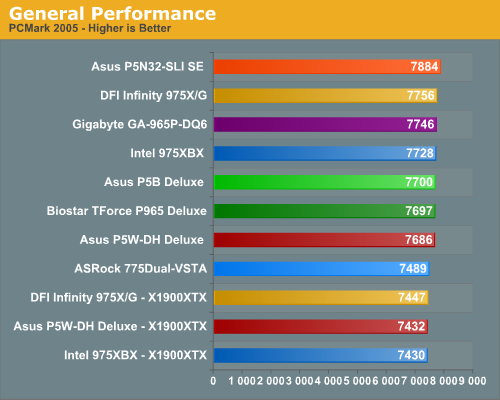
PCMark 2005 results for our test group are fairly close between the Intel chipset boards with the NVIDIA based ASUS P5N32-SLI SE taking a solid lead here due to excellent hard drive performance and multitasking scores within the benchmark. The three ATI X1900XTX equipped boards finished at the bottom of the group due to weak score results in the 2D benchmarks. Despite the close results in these tests with the Intel chipset boards, PCMark05 is still proving to be a useful overall performance benchmark. It is generally more sensitive than the older Winstones and PCMark04 to recent improvements in PC architecture.
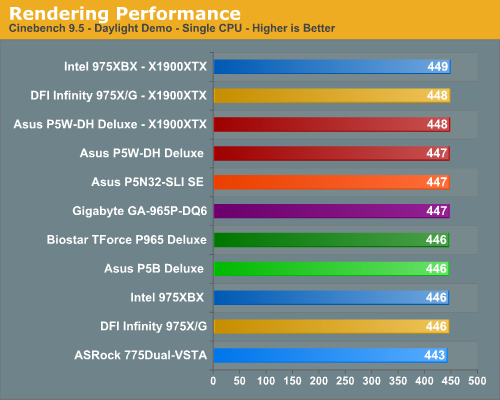
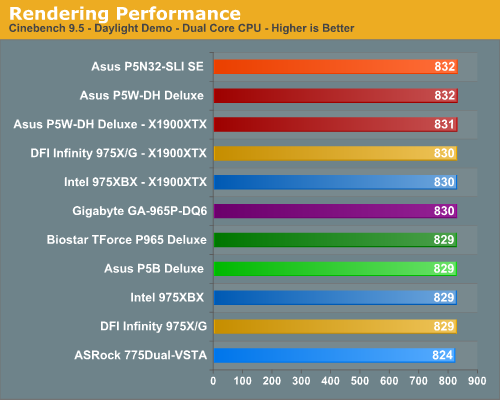
We have replaced Winstones with 2 benchmarks that use rendering to test system performance. Cinebench 9.5 heavily stresses the CPU subsystem while performing graphics modeling and rendering. We utilize the standard benchmark demo within the program along with the default settings. Cinebench 9.5 features two different benchmarks with one test utilizing a single core and the second test showcasing the power of multiple cores in rendering the benchmark image.
While results are generally close in Cinebench, the ASUS P5N32-SLI SE tops the Dual-Core test results with the Intel 975XBX finishing a strong first in the single core tests, followed closely by the ASUS P5W-DH in both tests.
The 3DMark series of benchmarks by Futuremark are among the most widely used tools for benchmark reporting and comparisons. Although the benchmarks are very useful for providing apple to apple comparisons across a broad array of GPU and CPU configurations, they are not a substitute for actual application and gaming benchmarks. In this sense we consider the 3DMark benchmarks to be purely synthetic in nature but still valuable for providing consistent measurements of performance.
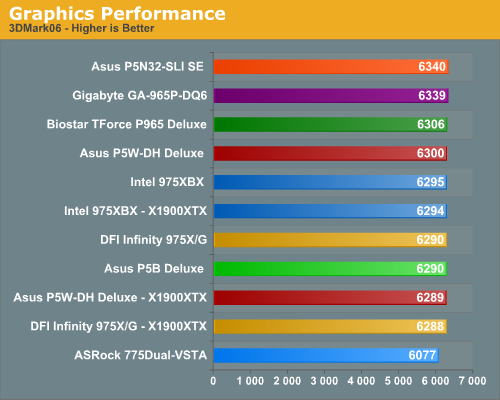
After taking a very strong first place in PCMark2005, we see the ASUS P5N32-SLI SE squeaking out a win in the 3DMark06 with an excellent performance turned in by the Gigabyte GA-965P-DQ6 for second place. The performance of the entire group was very close with the exception of the ASRock board due to its PCIe implementation (although a score over 6000 is still very respectable). The surprise was the ATI X1900XTX GPU scores as they have historically scored better in this benchmark than the NVIDIA based 7900GTX cards. We are still having conversations with ATI, but there appears to be a driver issue with the Core 2 Duo processors in our testing as the game scores will reflect the same results.
Overclocking Comparison
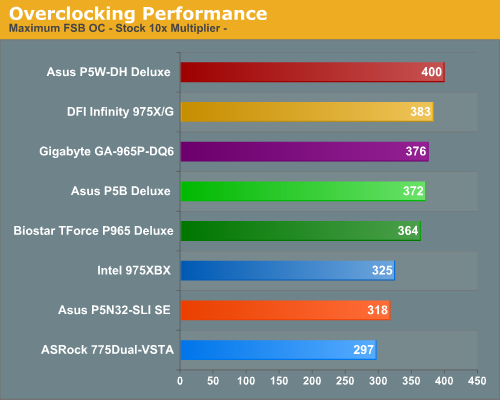
The overclocking capabilities we have measured thus far are with our standard E6700 CPU at a 10X multiplier. While this will not show the true FSB potential of the board, it does show a board's capability with the second highest performing Core 2 Duo and what can be expected with the fixed multiplier CPUs on average. We will be providing FSB overclocking results in our individual board reviews with the unlocked X6800. However, the only board in our testing that exceeded a 400FSB was the ASUS P5W-DH that reached 445MHz with our amazing little E6600 before running out of MCH voltage.
The NVIDIA based ASUS P5N32-SLI SE turned in a decent overclocking performance for an NVIDIA based Intel board but falls far short of the Intel chipset boards in high FSB overclocking. This situation will improve gradually over the next several months with the release of the DFI nF590 SLI board next month and then with the next true chipset revision this winter. Although the nForce4 Intel Edition board did not overclock competitively with the Intel chipsets when utilizing the FSB method, it did match the same overclocks when raising the CPU multiplier with our X6800 CPU.
The PCMark05 benchmark, developed by Futuremark, was designed for determining overall system performance for the typical home computing user. This tool provides both system and component level benchmarking results utilizing subsets of real world applications or programs. This benchmark is useful for providing comparative results across a broad array of graphics cards, CPUs, hard disks, and memory configurations and it also includes some multithreading results. In this sense we consider the PCMark benchmark to be both synthetic and real world in nature while providing consistency in our benchmark results.

PCMark 2005 results for our test group are fairly close between the Intel chipset boards with the NVIDIA based ASUS P5N32-SLI SE taking a solid lead here due to excellent hard drive performance and multitasking scores within the benchmark. The three ATI X1900XTX equipped boards finished at the bottom of the group due to weak score results in the 2D benchmarks. Despite the close results in these tests with the Intel chipset boards, PCMark05 is still proving to be a useful overall performance benchmark. It is generally more sensitive than the older Winstones and PCMark04 to recent improvements in PC architecture.


We have replaced Winstones with 2 benchmarks that use rendering to test system performance. Cinebench 9.5 heavily stresses the CPU subsystem while performing graphics modeling and rendering. We utilize the standard benchmark demo within the program along with the default settings. Cinebench 9.5 features two different benchmarks with one test utilizing a single core and the second test showcasing the power of multiple cores in rendering the benchmark image.
While results are generally close in Cinebench, the ASUS P5N32-SLI SE tops the Dual-Core test results with the Intel 975XBX finishing a strong first in the single core tests, followed closely by the ASUS P5W-DH in both tests.
The 3DMark series of benchmarks by Futuremark are among the most widely used tools for benchmark reporting and comparisons. Although the benchmarks are very useful for providing apple to apple comparisons across a broad array of GPU and CPU configurations, they are not a substitute for actual application and gaming benchmarks. In this sense we consider the 3DMark benchmarks to be purely synthetic in nature but still valuable for providing consistent measurements of performance.

After taking a very strong first place in PCMark2005, we see the ASUS P5N32-SLI SE squeaking out a win in the 3DMark06 with an excellent performance turned in by the Gigabyte GA-965P-DQ6 for second place. The performance of the entire group was very close with the exception of the ASRock board due to its PCIe implementation (although a score over 6000 is still very respectable). The surprise was the ATI X1900XTX GPU scores as they have historically scored better in this benchmark than the NVIDIA based 7900GTX cards. We are still having conversations with ATI, but there appears to be a driver issue with the Core 2 Duo processors in our testing as the game scores will reflect the same results.
Overclocking Comparison

The overclocking capabilities we have measured thus far are with our standard E6700 CPU at a 10X multiplier. While this will not show the true FSB potential of the board, it does show a board's capability with the second highest performing Core 2 Duo and what can be expected with the fixed multiplier CPUs on average. We will be providing FSB overclocking results in our individual board reviews with the unlocked X6800. However, the only board in our testing that exceeded a 400FSB was the ASUS P5W-DH that reached 445MHz with our amazing little E6600 before running out of MCH voltage.
The NVIDIA based ASUS P5N32-SLI SE turned in a decent overclocking performance for an NVIDIA based Intel board but falls far short of the Intel chipset boards in high FSB overclocking. This situation will improve gradually over the next several months with the release of the DFI nF590 SLI board next month and then with the next true chipset revision this winter. Although the nForce4 Intel Edition board did not overclock competitively with the Intel chipsets when utilizing the FSB method, it did match the same overclocks when raising the CPU multiplier with our X6800 CPU.










123 Comments
View All Comments
Gary Key - Wednesday, July 19, 2006 - link
We are looking forward to the value SLI boards in early August. Prices will range on average from $95 to $120. As soon as we can post a review up on these boards, it will be done. :)EODetroit - Wednesday, July 19, 2006 - link
Can Anandtech max out the memory and make sure these systems are stable in 64 bit Windows OS'? I'd really like to make sure that there's no time bombs if I buy 8GB of ram that will force me to RMA a lot of stuff. If you don't have 2GB sticks, at least test with 4x1GB. The motherboards advertise that they support 8GB, but no one ever seems to check them on it. If Anandtech could do that, it would be a great help.Thanks!
Genx87 - Wednesday, July 19, 2006 - link
Not bad for an older chipset to win the SLI benchmarks.I am curious what the new chipset can do!
supremelaw - Wednesday, July 19, 2006 - link
Dear Gary and Wesley,I'm thinking back to about 8 months ago,
when we first started assembling our
ASUS P5WD2 Premium motherboard
(which has recently become our primary
production machine).
We offered our assistance at the ASUS
User Forum, because a LOT of users
were stumbling over the IT8211F IDE
controller, which requires a device driver
to be extracted from the Support CD.
I fear that P965 motherboards are headed
for the same serious problems, particularly
if motherboards add an on-board IDE
controller that is NOT "native" e.g. JMicron.
Here's the scenario: a less-than-expert
user sees a PATA IDE port, and thinks
he can use (or recycle) a PATA optical
drive to run Windows Setup. And, he's
probably read (or heard) the stories about
SATA optical drives that just don't work
with Windows Setup.
Is this user headed for major problems?
I think so.
And here's why ...
If the BIOS has not been modified to
support native PATA / IDE optical devices,
a Catch-22 results: you need the device
driver from the Support CD, but you can't
read the Support CD without the device
driver -- not if the optical device is wired
to that on-board IDE controller.
If you want confirmation of this problem,
check out the ASUS User Forum for the
P5WD2 Premium, particularly the numerous
complaints Users were posting about the
ITE IT8211F on-board IDE controller.
To make this problem even more exasperating,
the User Manual failed to mention that the
F6 sequence will load the ITE driver during
Windows Setup, BUT one can STILL not
run Windows Setup from an optical drive
wired to that ITE controller. The device driver
can be added AFTER Windows XP is
successfully installed.
Fortunately, the P5WD2 Premium has a
BLUE native IDE port as well, and we
avoided all of these problems by running
Windows Setup from a PATA optical drive
wired to that BLUE native IDE port.
Thanks for all the great reviews!
Sincerely yours,
/s/ Paul Andrew Mitchell
Webmaster, Supreme Law Library
http://www.supremelaw.org/">http://www.supremelaw.org/
Gary Key - Wednesday, July 19, 2006 - link
Hi Paul,The scenario you listed is a very real possibility and as you have noted has existed in past boards. In fact, I was on the phone with Wes when our first P965 was fired up and the Optical Drive was not recognized. Of course, I had a few choice words to say about the situation. The only way to load the new OS image and Driver CD was through the Optical drive and that was not going to happen in this case. I ended up loading a new image on a drive in another system, installing the inf and network drivers in a folder, and then moving this drive to the new machine. The issue was a very early bios that did not support the hooks from the external IDE chipset into the ICH8. We received an updated bios a few days later and all was well from that point forward.
Since Intel has basically left a "lane" open in the ICH8 to support IDE (much in the same way as the LAN controller logic, being real simple here to keep it short), then the only issue is to ensure the bios has support for the IDE link. We have not seen this issue at all in the latest boards that we have received and have been told it will not occur in shipping boards. While most suppliers are going with the JMicron solution, Biostar included the VIA VT6410 that turned out to offer excellent performance in our upcoming storage tests. I hope this helps and thank you for your comments today.
:)
Andy4504 - Wednesday, July 19, 2006 - link
I was most surprized by the poor BadAxe (X975XBX) Overclocking. Because the memory controller isn't directly tied to the FSB speeds, the fact that you cannot incrase the memory voltage without hardware modification should make little / no difference in CPU overclocking.I personally own a X975XBX with an 805D. I've found that the best overclocking isn't done by selecting +30% OR + any percent for that matter, but rather choosing the higher bus speed, then selecting an underclock from that higher speed.
With full access to the memory multiplier range, most any ratio could be set.
Wesley Fink - Wednesday, July 19, 2006 - link
Conroe runs at 1066 FSB speed. 1333 support has been in and out of the different BIOS revisions. So with Conroe you can select no higher bus speed at worst, or a modest 1333 at best. 805D runs at 533 (166 quad) so you have differnt options. It really isn't possible to select higher bus speeds and clock down with Conroe on the BadAxe.Paladin165 - Wednesday, July 19, 2006 - link
In the review you mention that the 7600GT would work with the cheap ASrock board, I was thinking about going with this setup (if another ultra-cheap board doesn't come out soon). I was wondering, how much impact would the 4x PCIex speed have on the 7600GT? Are there any situations where it would choke off performance? Does it provide enough power?This cheap board seems like a good buy because new motherboards are going to be coming out so rapidly over the next six months it doesn't make sense to drop $250 on a bleeding-edge board.
Gary Key - Thursday, July 20, 2006 - link
The 7600GT works fine. I am trying to procure a 7600GS PCIe and AGP cards to directly compare the video performance on the board. Hopefully, I will have both cards before the full review goes up. We also have two other ASRock boards that are under $75 arriving shortly. I think the performance with the 7600GT will be fine unless you like to play Oblivion and even with the PCIe x4 interface you will not notice a real difference with this card.Paladin165 - Thursday, July 20, 2006 - link
"I think the performance with the 7600GT will be fine unless you like to play Oblivion"!!!
Oblivion is exactly what I want to play! What is it about this setup that hurts Oblivion performance?